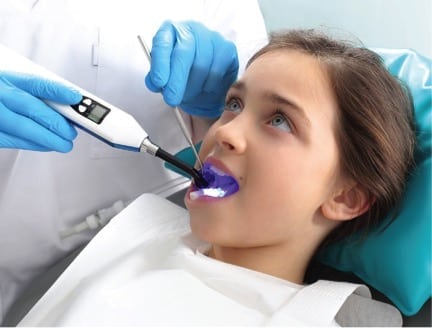 Have your child’s molars been sealed? The U.S. Centers for Disease Control and Prevention (CDC) this fall reported that dental sealants can reduce cavities by up to 80 percent during the first two years after they are applied, by up to 50 percent for the two years after that, and continue working for as long as nine years. CDC Director Tom Frieden even proposed school-based sealant programs so that more kids would get them. Paired with fluoride applications, sealants do a good job of protecting teeth. But they won’t do the trick all by themselves.
Have your child’s molars been sealed? The U.S. Centers for Disease Control and Prevention (CDC) this fall reported that dental sealants can reduce cavities by up to 80 percent during the first two years after they are applied, by up to 50 percent for the two years after that, and continue working for as long as nine years. CDC Director Tom Frieden even proposed school-based sealant programs so that more kids would get them. Paired with fluoride applications, sealants do a good job of protecting teeth. But they won’t do the trick all by themselves.
“There are some people who like to equate either a sealant or a fluoride application with a vaccine. I don’t think that’s a good analogy,” says James Crall, chair of Public Health & Community Dentistry at the UCLA School of Dentistry. “You’re not good to go for life.” Sealants are a plastic coating bonded to the surface of the teeth as each set of a child’s molars comes in – one when the child is 5 and the other around age 12. They are applied to the chewing surfaces of the teeth, which are rough and covered with pits and fissures. “Those are the areas where bacteria tend to accumulate,” says Crall, adding that these spots are often too small for the bristles of a toothbrush to reach.
But sealants can be tricky to apply, and any moisture that comes between the tooth and the sealant material during application can keep it from bonding to the tooth. This means that the sealant should be checked during regular dental exams to make sure it is still in place. If a portion has worn away, it is easy for the dentist to reseal that portion.
Crall points out one other important thing to keep in mind about sealants: “The sealants are only protecting a portion of the tooth.” For the smooth surfaces of the teeth, fluoride treatments applied by the dentist offer good protection. And proper dental hygiene at home helps remove food and debris and keep the gums and bones that hold the teeth in place healthy. “that daily tooth brushing, particularly with a fluoride toothpaste, is really important,” Crall says.
During the early years after a child’s permanent teeth come through, the enamel isn’t mature and the child isn’t yet able to brush effectively without help. So parents need to make sure their dentist protects the teeth with sealants and fluoride, and that the child brushes carefully each day.























